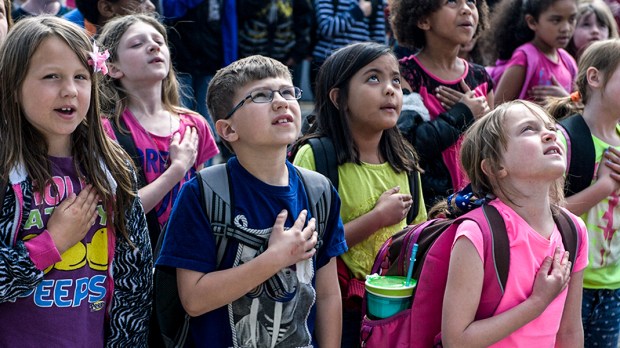Today, October 12, the traditional date for Columbus Day, is the anniversary of the first recitation in public schools of the Pledge of Allegiance.
The Pledge of Allegiance was composed in August 1892 by Francis Bellamy, a Baptist minister who went to work for a popular children’s magazine, The Youth’s Companion. The first recitation was part of the National Public-School Celebration of Columbus Day, on the 400th anniversary of Christopher Columbus’s arrival in the New World. It coincided with the opening of the World’s Columbian Exposition (the Chicago World’s Fair) in Illinois.
Bellamy and James B. Upham, a marketer for the Youth’s Companion, had arranged for Congress and President Benjamin Harrison to announce a proclamation making the public school flag ceremony the center of the Columbus Day celebrations.
Smithsonian magazine said that Bellamy believed the Pledge should invoke allegiance. “The idea was in part a response to the Civil War, a crisis of loyalty still fresh in the national memory” when he penned the words, the magazine said.
Years later, in 1954, in response to America’s Cold War against godless Soviet communism, Congress approved the addition of the words “under God.” The Knights of Columbus and others lobbied for the additional words.
In June 2004, the U.S. Supreme Court ruled unanimously to keep “under God” in the Pledge.
Interestingly, the Pledge originally came with what today might be considered an unusual posture. According to the website US History, Bellamy first prescribed that children begin the Pledge with a military salute, then extend the arm toward the flag after reciting the words “to the flag”:
At a signal from the Principal the pupils, in ordered ranks, hands to the side, face the Flag. Another signal is given; every pupil gives the flag the military salute — right hand lifted, palm downward, to a line with the forehead and close to it. Standing thus, all repeat together, slowly, “I pledge allegiance to my Flag and the Republic for which it stands; one Nation indivisible, with Liberty and Justice for all.” At the words, “to my Flag,” the right hand is extended gracefully, palm upward, toward the Flag, and remains in this gesture till the end of the affirmation; whereupon all hands immediately drop to the side.
“Shortly thereafter, the pledge was begun with the right hand over the heart, and after reciting ‘to the Flag,’ the arm was extended toward the Flag, palm-down,” the website continued. “In World War II, the salute too much resembled the Nazi salute, so it was changed to keep the right hand over the heart throughout.”
And that’s the practice that continues to this day.

